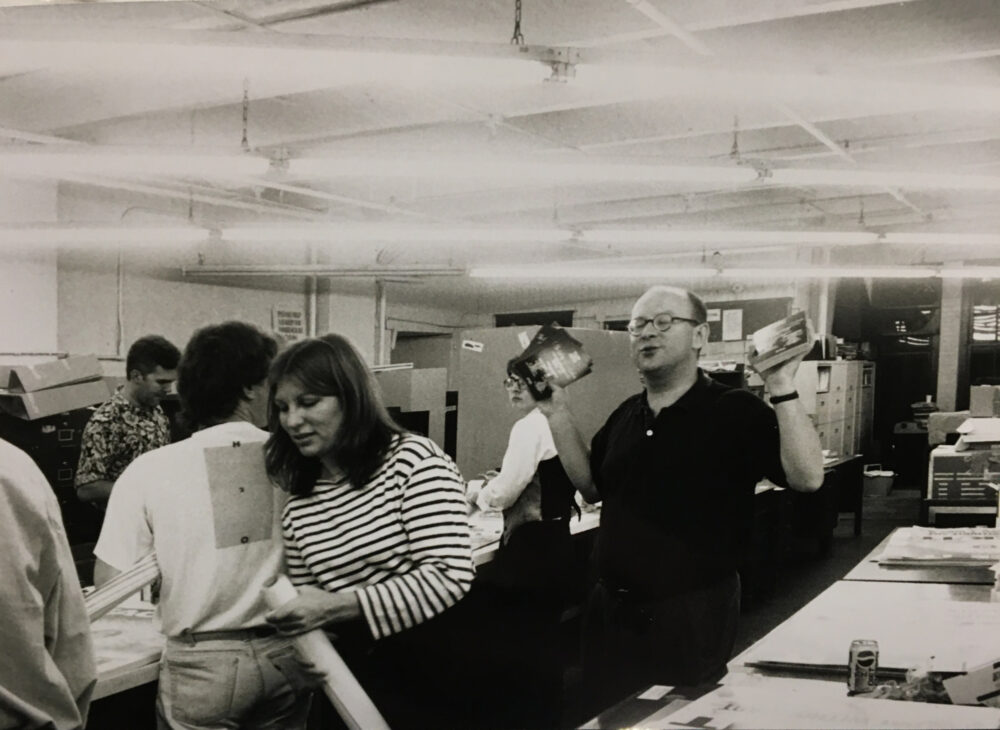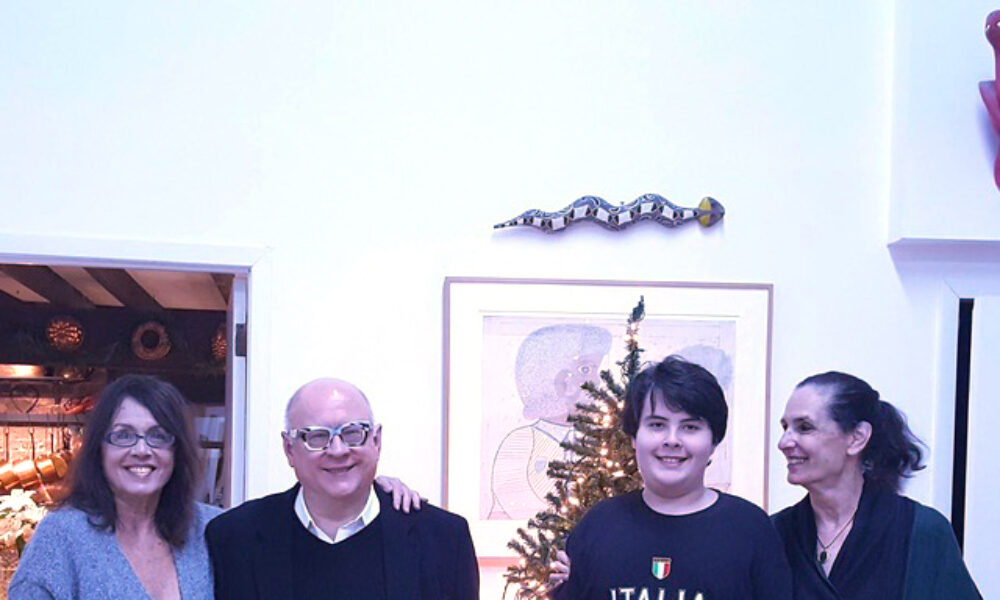Visual AIDS mourns the loss of Thomas Sokolowski (1950–2020), one of our four founders.
Tom served as the director of the Grey Art Gallery at NYU for many years before moving on to direct the Andy Warhol Museum and the Zimmerli Art Museum at Rutgers University.
In early 1988, Tom and three fellow arts professionals—Robert Atkins, Gary Garrels, and William Olander—wrote a letter to their colleagues inviting them to join Visual AIDS, a collective effort to “coordinate, encourage, and facilitate the presentation and discussion of AIDS-related art.”
Tom hosted the group’s first meeting at the Grey Art Gallery, in the context of a show he had curated, Rosalind Solomon: Portraits in the Time of AIDS, one of the first exhibitions of AIDS-related photography. He went on to play a central role in organizing Visual AIDS’ first major project, Day Without Art, coordinating 800 art museums, galleries, and non-profit spaces for a day of mourning and action in response to the AIDS crisis.
In a 2019 interview with Jackson Davidow, Tom reflected on his time at the Grey and his involvement in Visual AIDS:
Because I was a gay man and interested in activism, I worked to make the Grey Art Gallery one of the few places at the time that presented both gay and AIDS-related work. At New York University, people were looking at AIDS from the perspectives of social history, epidemiology, and so forth. I believed that it was also important for a university gallery to contribute to these conversations.
I felt I had an obligation to talk about the AIDS crisis for my community and for the communities around me, especially those of art, culture, and literature. Once I was talking to some vice president who called us the “Gay Art Gallery” and asked why we were doing so many AIDS shows. And I said, “If I found that everyone was doing blue still lifes, hundreds of them around New York or wherever, I would say, there’s something to this. We have to look into it!” When you have that many artists making work about AIDS, you’ve got to take it seriously. 1987 was when the stock market crashed. This was a time when galleries weren’t selling anything because people didn’t have any money. So artists said, “Fuck it, if I’m not going to sell anything, then let’s make something that could be really important.”
At our first meeting for what became Visual AIDS, I said, “Hey, I was just looking through The Village Voice, and there’s going to be a poetry reading about AIDS, a photography show about AIDS, a theater piece about AIDS... If we can just put everything together in a press release and send it to the press, there’s a story.” We sort of began as a press agency, and it bloomed into many other things
Tom used his encyclopedic knowledge of art history to situate art about AIDS in a long lineage of artists responding to crisis and plague, and to advocate for the political potential of art. In 1992 he curated From Media to Metaphor: Art About AIDS with Robert Atkins, one of the first touring museum exhibitions to address the subject. He served on Visual AIDS’ Board of Directors for many years before moving to Pittsburgh to direct the Andy Warhol Museum.
In remembrance of Tom’s steadfast commitment to the power of art, we are sharing an excerpt from the speech he gave during the Museum of Modern Art’s observance of the second Day Without Art in 1990:
Why are we here tonight? Standing within this great collection of masterpieces, frozen still in time, cosseted and closed off from reality, we seem far removed from the AIDS pandemic. The New York City death toll which, even as I speak, mounts to the catastrophic sum of 29,181 appears as a menacing specter whose shadow looms on the horizon… Do we not delude ourselves that art can actually save lives? A pill of AZT can save lives. A cheque written to the Community Research Initiative or Gay Men’s Health Crisis can save lives. A clean needle can save lives. Safer sex practices can save lives. Proper public education, fully-equipped health care facilities, sufficient health insurance, adequately sponsored research and drug testing should save lives, but shamefully, have not. In the face of civic, state, and federal bureaucracies which move either too slowly or not at all, one stands aghast in incredulous disbelief and with burning outrage…
Why, then, are we here tonight? I, like all of you here tonight, share the belief that art can and does effect change. It must do so. Art can bother people in a way that no other form of communication can… Art, when directed to social change, becomes a powerful manifestation of the human spirit to survive, rebel, commemorate, and most of all effect change. Art and artists, whether the message be sweet or acrid search for the truth; truth not in some absolutist notion, but rather truth that empowers…
This is why we have come here this evening. I look out at you tonight and see many of my fellow members of Visual AIDS, and feel an inordinate sense of pride and gratification… and hope. Hope even in the face of the AIDS pandemic. The many images produced and exhibited for Day Without Art are not expressions of guilt or penance, but rather of struggle and courage. This will continue. Tomorrow night, the skyline of New York City will darken for fifteen minutes in a mass performance piece called Night Without Light…. When the skyline darkens and then bursts once again into life-affirming light, I would like you to remember the words of performance artist Penny Arcade, who said, “Whenever I hear the name A Day Without Art, I think of a Day Without AIDS.” That is why we are here tonight.
Below are written tributes from some of the people who knew Tom, as part of the Visual AIDS family and beyond.
Robert Atkins, co-founder of Visual AIDS:
The news of Tom's death is devastating. He was a remarkably talented museum director and curator, and a generous, supportive friend. He was fun and funny, amused and bemused by a world he never seemed to tired of. I'm oddly glad it wasn't COVID-19 that killed him. We spent so much time together working to ameliorate the effects of another virus and another fatally ignorant regime, that this moment brings it (and him) back in especially vivid relief. I can hear Mathilde Krim, founder of AmFAR, telling us: "Each step in the escalation of the AIDS crisis was predictable and could have been countered." Perhaps they're chatting in heaven now
Gary Garrels, co-founder of Visual AIDS and Senior Curator of Painting and Sculpture at SFMOMA:
Tom and I arrived in New York the same year—1984—and very quickly the program he was developing at the Grey Art Gallery caught my attention. Somewhere along the way we were introduced and then became friends. Openings at the Grey Art Gallery were not to be missed. Fresh, smart, wonderfully presented exhibitions, but just as good were Tom's remarks at the openings, new ideas dropped like little detonations for the mind, droll and sharp. When I became the Director of Programs for the Dia Art Foundation in 1987 with our office in Soho, our paths would cross constantly, and conversations would become evenings together. He had no hesitation to challenge an idea, to look askance at accepted discourse, to raucously poke a pin into the art world. His curiosity was wide and deep. He cared profoundly about art and about people.
As the AIDS crisis unfolded, we both felt extremely frustrated about how our commitments to art and artists could matter, make sense, make a difference within the devastation. We convened one evening at my office with two other colleagues, the art writer Robert Atkins and Bill Olander, curator at the New Museum, whose office was just around the corner from mine, to talk about something we might do and from that each of us reached out to more colleagues and convened a larger meeting. From that Day Without Art was born, which quickly grew and metamorphosed into Visual AIDS. Tom galvanized our efforts, took off running with it. His intelligence, care, and dedication brought focus and momentum to our vision. He was the one who really made it happen. There never can be enough thanks to Tom.
Sur Rodney (Sur), former co-director of Gracie Mansion Gallery (1982–88) and a former Visual AIDS board member (1995–2010):
Tom Sokolowski was among the art world enthusiasts who would regularly visit the East Village galleries in the 80s. That is how I met him. He was inspired by many of the artists Gracie Mansion and I were working with, and included several of them in his curatorial projects. Then AIDS happened. That foregrounded other concerns.
During that period of chaos, a group of gay men in the art world, aligned with what was happening to our art world community in crisis, had many urgent occasions for community meetings and socializing. This provided an opportunity for me to get to know Tom more personally, before his move to Pittsburg as director of the Warhol Museum.
It would be a quarter century before Tom would come back into my life in the most unexpected way -- as director of the Zimmerli Museum enlivening my prior relationship with the Museum, imaginatively and creatively. Tom had a remarkable talent of a noteworthy caliber, evidenced in the work he’s accomplished over decades. I will always remember him for that, his humor, wit, and his wholeheartedness.
Claudia DeMonte, artist:
What would Tom want us to remember… not just a list of accomplishments, of which there are many… but perhaps that he was a decent man, raised by a hard working family, proud to be Polish, insightful about others, inclusive of all. He had an innate sense of what mattered, what was right, what was just.
Personally, besides exhibiting and writing about both my and my husband, Ed McGowin’s work, he became part of our family. Spending many holiday dinners with us in Soho and Astoria, relishing in my sisters amazing Italian Seven Fishes Christmas Eve and sharing his Polish Oplatki tradition. He became Zio Tom to my nephew Sandro.
We both had mothers that had strokes, and had long stories about their inner strength. He cared deeply about those he loved. His LONG telephone calls were always filled with updates on his inner circle of close friends. .. his chosen family.
My mind is filled with images, flamboyant scarves, round glasses, great meals, white wine and Tom imitating Chinese Opera.


